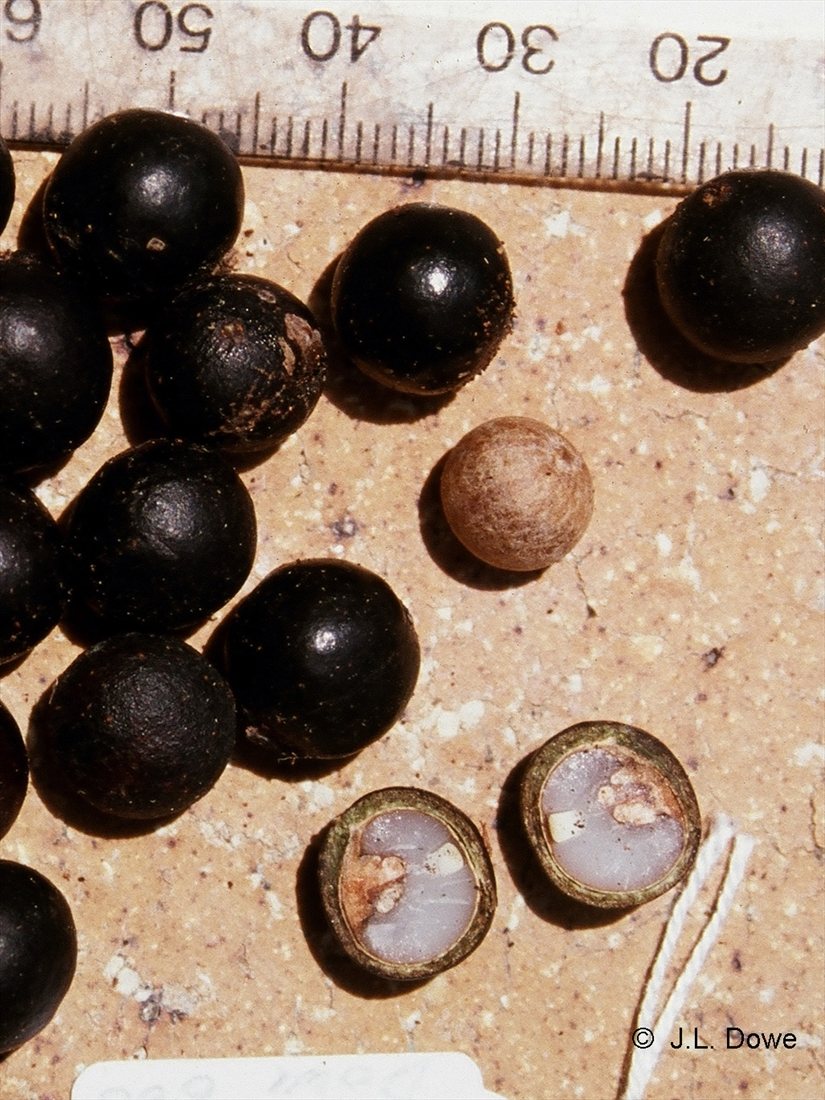Australian Tropical Rainforest Plants - Online edition
Livistona concinna Dowe & Barfod






Dowe, J.L. & Barfod, A.S. (2001) Austrobaileya 6(1): 166-169. Type: Queensland. Cook District: 16 km north of Cooktown, just north of the Cooktown Airport, Barrett Creek, 15 25S, 145 11E, 5 m alt., 17 Oct 2000, J. L. Dowe 607 (holo: BRI; iso: AAU, K, QRS).
Kennedy River livistona; Cooktown fan palm; Cooktown livistona
Solitary trunks to 30 m tall, dbh 24-35 cm, expanded at the base to 100 cm diam., grey, nodes raised; internodes 2-12 cm wide. Plants male or female.
Leaves 50-65 in a globose crown; petioles 120-300 cm long, glabrous, green, 5-11 cm wide at base, 2.2-3.5 cm wide in mid area, triangular in cross-section, margins with solitary symmetric black spines 3-5 mm long congested in the proximal portion with the distal margins unarmed, sharp and slightly winged; leaf-base fibres persistent; lamina costapalmate, glabrous and glossy green, 155-165 x 200 cm, folded; segments 60-78 with deeply forked apices, distal portion pendulous; segments free for ca. 60% of their length, and with an apical split. Longitudinal veins 9-10 each side of the midrib, parallel.
Inflorescence an unbranched axis with several partial inflorescences decreasing in size toward the apex, sexually dimorphic; male inflorescences 120-180 cm long with 8-9 partial inflorescences; peduncle dorsi-ventrally compressed and 20-25 x 10 mm, glabrous; female inflorescences 160-250 cm long with the partial inflorescences 8-9; peduncle dorsi-ventrally compressed, ca. 30 x 10 mm; peduncule lacking empty bracts; prophyll 27-35 cm long, glabrous; bracts on rachis 30-50 cm long, tubular and tightly sheathing, apex acute with margins entire; rachillae 5-20 cm long. Flowers solitary/in clusters of 2-4, 1.6-2 x 2 mm; sepals basally fused, cupular, 3-lobed and triangular with acute apices; petals triangular, 2-2.2 x1.8-2 mm; stamens ca. 1 mm long; styles fused, ca. 1 mm long, stigma 3-lobed.
Fruit globose, 9-12 mm diam., shiny black; stigmatic remains subapical; epicarp smooth with scattered lenticellular dots; mesocarp ca. 1 mm thick, moist, oily and gritty in texture; endocarp thin, crustaceous, light brown, 0.1-0.2 mm thick. Seed globose to subglobose.
The cataphylls or sheath that the first leaf emerges through ca. 3.5 cm long, creamy white. Lead blade pleated, ca. 14.5 cm long, petiole 4 cm long. 10th leaf petiole armed witth small recurved spines, blade ca. 20 x 3 cm, petiole 16 cm long. Longitudinal veins about 8-9. Reticulate veins short and sinuous. Oil dots if present are sparsely scattered.
Occurs in NEQ near Cooktown and in the Lakefield National Park. Altitudinal variation from near sea level to 100 m. Grows in seasonally open riparian rainforest, vine forest and Melaleuca swamp, along creeks and rivers.





